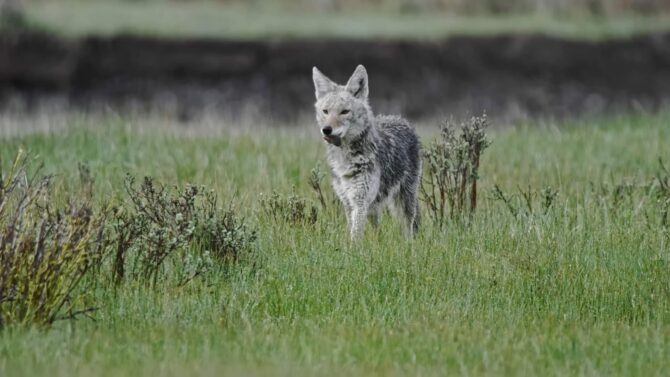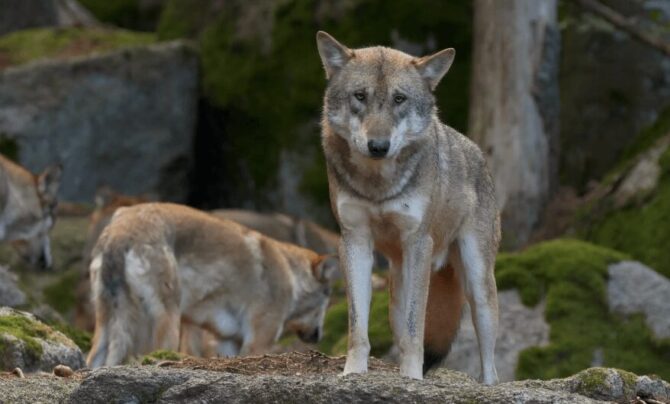Wolves have long fascinated humans with their enigmatic presence, symbolic significance, and complex behaviors. One intriguing aspect that often generates debate and curiosity is their diet.
Are wolves omnivorous, or are they strict carnivores? This question invites us to explore the world of wolves and their dietary habits.
In this blog post, we will dissect this topic, providing an insight into the wolf’s diet.
Key points:
- Discover why wolves are classified as obligate carnivores and how they occasionally show omnivorous tendencies.
- Learn about the wolf’s specialized digestive system and its adaptation to a predominantly meat-based diet.
- Understand the ecological role of wolves as apex predators and their impact on ecosystem health and balance.
- Explore the complex social behavior of wolves, including pack dynamics, communication, and adaptability across various habitats.
- Gain insights into the challenges and strategies of wolf conservation, including human-wolf coexistence and the importance of ongoing research.
The Wolf’s Dietary Classification

Wolves are primarily known as obligate carnivores. This means that their diet fundamentally revolves around meat.
They are apex predators, which positions them at the top of the food chain, and they typically hunt in packs to take down large animals.
Their preference for large ungulates like deer, elk, and moose is well-documented.
Lone wolves, which may not have the advantage of hunting in packs, tend to target smaller prey like rabbits, hares, and snakes, but their diet remains predominantly meat-based.
Opportunistic Eating Habits
Despite being classified as carnivores, wolves are also opportunistic eaters. This trait is crucial for survival, especially in harsh or challenging environments.
Wolves will consume smaller animals and carrion when the opportunity arises. This versatility in their diet is proof of their adaptability as a species.
Rare Instances of Omnivorous Behavior

Wolves have been observed to occasionally consume non-meat items such as berries, fruits, and grasses. However, these instances are relatively rare and typically occur when traditional prey is scarce.
It’s important to note that while wolves may exhibit omnivorous behavior under certain circumstances, their digestive system is not optimally designed to process plant material.
Thus, these plant-based foods do not constitute a significant part of their diet.
Digestive System and Diet
The wolf’s digestive system is specifically adapted for a carnivorous diet.
This adaptation is evident in their strong jaws, sharp teeth, and digestive system optimized to process meat and animal-based proteins efficiently.
Their physical attributes are a clear indication of their natural inclination towards a meat-centric diet.
Limited Capacity for Plant-Based Foods
While wolves can consume plant-based foods, their digestive system is not ideally suited for processing such materials.
The consumption of fruits, berries, and grass is more a survival strategy than a dietary preference.
These items provide minimal nutritional value to wolves and are often consumed out of necessity rather than choice.
Survival in Unsuitable Conditions
The ability of wolves to occasionally consume plant-based foods is a testament to their remarkable adaptability.
In unsuitable conditions where traditional prey is scarce, wolves can survive by supplementing their diet with available vegetation.
However, this is not their preferred or optimal dietary choice.
Behavioral and Ecological Insights
Pack Hunting and Prey Selection

Wolf packs are known for their strategic and cooperative hunting techniques. This pack behavior is integral to their ability to hunt large prey.
The selection of prey is based on various factors, including the size, health, and availability of the animal.
Wolves play a crucial role in maintaining the ecological balance by often targeting weaker or sick individuals in a herd.
Lone Wolves and Diet Variation
Lone wolves, which operate without the support of a pack, have a different approach to hunting.
They are more likely to target smaller prey due to the challenges of hunting larger animals alone.
This variation in diet among lone wolves is a fascinating aspect of their adaptability and survival strategy.
Ecological Impact of the Wolf’s Diet
The dietary habits of wolves have significant ecological implications.
As apex predators, wolves help regulate the populations of their prey, which in turn affects the overall health and balance of the ecosystems they inhabit.
Having knowledge about the wolf’s diet is crucial for appreciating their role in nature and the importance of their conservation.
The Role of Wolves in Ecosystems

Wolves play a pivotal role in maintaining the balance of ecosystems. As apex predators, they help control the populations of various animals, ensuring that no single species dominates the landscape.
This control is essential for preserving biodiversity and the health of ecosystems.
For instance, in regions where wolves prey on deer, they indirectly contribute to the flourishing of plant life, as reduced deer populations lead to less grazing.
Impact on Other Species
The presence of wolves in an ecosystem also has a cascading effect on other species.
For example, by controlling the population of herbivores, wolves indirectly support the growth of vegetation, which benefits a multitude of smaller animals and insects.
Furthermore, the remains of their prey provide food for scavengers and decomposers, showcasing the interconnected nature of ecosystem components.
Indicators of Environmental Health
Wolves are often considered indicator species, meaning their presence and health reflect the overall condition of their habitat.
A stable and thriving wolf population typically indicates a healthy ecosystem with robust biodiversity.
Conservation efforts aimed at protecting wolves, therefore, have broader implications for ecosystem preservation.
Wolf Behavior and Social Structure
Pack Dynamics

The social structure of wolf packs is a complex and fascinating aspect of their behavior. Packs are usually family units consisting of a mating pair and their offspring.
The hierarchical structure within a pack is essential for maintaining order and efficiency, especially during hunts.
Leadership roles are often taken by the alpha male and female, but the dynamic can change based on various factors, including age, strength, and social interactions.
Communication and Territory
Wolves are highly communicative animals, using a variety of vocalizations, body language, and scent marking to convey information.
Howling, for example, plays a vital role in maintaining pack cohesion, defining territory boundaries, and coordinating hunts.
Territorial behavior is crucial for these animals, as it ensures sufficient hunting grounds and reduces conflicts with neighboring packs.
Adaptability in Various Habitats

Wolves are incredibly adaptable creatures, capable of thriving in diverse habitats ranging from the Arctic tundra to dense forests and mountains.
This adaptability extends to their hunting strategies and social structures, which can vary based on the environment and available resources.
Human-Wolf Interactions
Conflict and Coexistence
Human-wolf interactions have historically been fraught with conflict, primarily due to competition for resources and the perceived threat wolves pose to livestock.
However, increasing awareness and conservation efforts are leading to more strategies for peaceful coexistence.
These include the use of non-lethal deterrents, habitat restoration, and public education about the ecological importance of wolves.
The Role of Wolves in Culture and Mythology
Wolves hold a significant place in the mythology and folklore of various cultures, often symbolizing strength, intelligence, and the wild spirit of nature.
Knowing these cultural perspectives is crucial for fostering a deeper appreciation and respect for these animals, which can aid in their conservation.
Conservation Efforts

Conservation efforts for wolves are multifaceted, involving habitat protection, legal protection, and efforts to mitigate conflicts with humans.
The reintroduction of wolves in certain areas, such as Yellowstone National Park, has demonstrated the positive ecological impact they can have.
Ongoing research and monitoring are essential for ensuring the continued success of these efforts.
FAQs
Can wolves digest grains or other agricultural products?
They are not adapted to digest grains or agricultural products efficiently. Their digestive system is primarily designed for processing meat, making it difficult for them to derive nutritional value from such foods.
Do wolves hunt and eat fish?
Yes, some wolf populations, particularly those living near water bodies, have been known to hunt and eat fish.
This behavior is more common in areas where traditional prey is less abundant.
How does the diet of a wolf change with the seasons?
They adjust their diet based on the seasonal availability of prey. In winter, they may hunt larger ungulates weakened by the cold, while in summer, they might target smaller animals or, in rare cases, consume available berries or fruits.
Are there any known health issues in wolves due to their carnivorous diet?
These animals are generally well-adapted to a carnivorous diet. However, like any species, they can face health issues due to malnutrition if prey is scarce or if they consume contaminated prey.
How do wolves ensure they get enough water in their diet?
They typically get most of their water needs from the prey they consume.
They also drink water from natural sources like rivers, lakes, and puddles, especially in warmer weather or during periods of high activity.
Do wolves ever store or cache their food?
Yes, these animals sometimes cache their food, especially in times of abundance. They bury parts of their kill to consume later, which can be crucial for survival during times when hunting is less successful.
Final Words
Wolves are not omnivorous animals in the traditional sense. They are obligate carnivores with a strong preference for a meat-based diet.
Their occasional consumption of plant-based foods is more a survival strategy than a dietary choice.
The wolf’s dietary habits, along with their hunting behaviors and ecological impact, offer a fascinating glimpse into the complex and adaptive nature of this remarkable species.
Knowing these aspects of their life is essential for appreciating wolves not just as predators but as integral components of the natural world.






